Change is inevitable, which is why communicating change is so important. We know it can be a challenge, so here are some tips and guidelines to make it easier.

.png)
Strategy is an important component of internal communications. Ensure you’re communicating through the right channels at the right frequency with our Internal Communications Channel Audit worksheet.
Access NowThe ability to be strategic in business relies partly on the ability to plan ahead. Furthermore, to remain competitive in today’s constantly changing business environment it’s essential for organizations to evolve and adapt business strategies. The universal problem is that people in organizations are typically resistant to change, even when they know it’s needed. A direct result is that they don’t plan sufficiently for change — often until it’s too late.
Gallagher’s State of the Sector 2023/24 Internal Communication and Employee Experience survey report highlights the problem.
According to Gemma O’Hara, director of Change Communication at Gallagher, only 42% of respondents report having an “overarching strategic plan” for the year. While 90% of communicators say they expect change during 2024, only 25% are involved with leadership in a planning capacity.
“How can communicators plan for success if they can’t see what’s coming? With decreasing budgets and shrinking teams, maybe internal comms professionals are spread too thin to get ahead of change? As the comms function is ultimately responsible for engaging employees with transformation, perhaps it’s time that senior leaders recognize the importance of involving communicators in change early in the process — particularly when it could make or break the business’ transformation strategy.”
Gemma O’Hara
“Change initiatives often fail simply because of a lack of communication and people skills,” says Maddy Rieman, head of Customer Success at Cerkl. “That’s why it’s so important to ensure that your internal communications strategy encompasses effective change management.”
Recognizing that change in various guises is inevitable, Maddy discussed the topic during our recent workshop at the 11th Annual Strategic Internal Communications - West Conference in San Francisco. As a result, she pinpoints comms in times of change as one of the 10 top challenges internal communicators and HR managers need to come to terms with.
Change can be debilitating to individuals and organizations. However, the global turbulence of COVID-19 shifted everyone’s lives around for two to three years. Some more than others. As a result, communicating change became a monumental challenge.
“Of course, these things have always happened throughout history. But, this time, it was on a scale, much larger than ever before,” says Maddy.
“Businesses had to get creative during the pandemic and figure out how they could manage so many pivotal changes, not only to their workforce but to the entire business. Now, four years later, companies are still trying to find their new normal.”
Internal communicators were faced with a kind of change most had never envisaged. “They had to manage a transition, not only within their roles but also in terms of the value they bring to organizations. We found out very quickly through COVID-19 that many companies weren’t well equipped to handle such a transition.
“Without warning or the opportunity to plan ahead, companies had to move entire divisions, departments, and sometimes the entire organization to a remote environment. How would companies manage systems practices and their day-to-day work without the equipment they had handy in the office? How would they access systems that were typically blocked outside of the four walls of their headquarters?
“Suddenly, communicators were responsible for executing a new way of work.”
“After a surge in hiring, many companies were forced to endure significant layoffs,” says Maddy. “Adding economic uncertainty and overall global chaos, how does a communicator adequately deliver essential comms during such a turbulent time?
“We saw companies turn their focus to the internal communication function. How else were they able to articulate such drastic changes without the aid of those who communicate best? And it was about damn time…
“Finally, internal communicators - the people who were tasked with communicating change — were starting to be seen as key stakeholders. However, many companies didn’t have the teams, resources, and technology needed to execute these critical changes and shifts.
“Now we’re at a point where we’re seeing a massive surge in mergers and acquisitions as well as an incredible amount of leadership change.”
Clearly, change communications has never been more important!
Upgrade your company’s internal comms to enhance employee communication
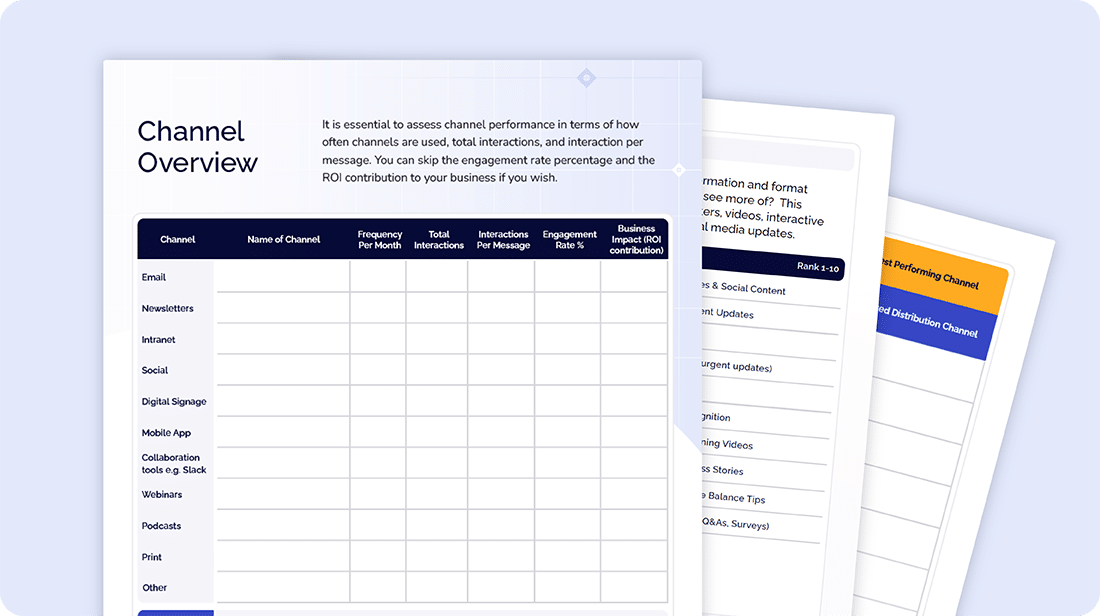
Thankfully, global events like COVID-19 don’t happen often. But companies are frequently faced with organizational change.
These changes might stem from the desire or need to improve efficiency, adapt to new market trends, or implement new technologies. Typically, they are strategic moves aimed at ensuring the long-term success and sustainability of the organization.
At the same time, organizational change is often made in response to internal or external pressures. It can be complex, commonly affecting various aspects of the business from its people to its process. For this reason, organizational change necessitates a careful balance between the current organizational ethos and the envisioned future.
In an article on the Harvard Division of Continuing Education page, Mary Sharp Emerson echoes the sentiments of Maddy Rieman. Assistant director of HR Communications at Harvard, Mary states that a lack of effective communication is one of the most common reasons why change management strategies fail.
Her article, 7 Reasons Why Change Management Strategies Fail and How to Avoid Them, talks about the challenges of change management. She points out that people “are often highly resistant to change, even when we know it’s necessary.” Because of this, adopting new strategies for a change initiative can be “difficult and often messy. And the consequences of a poorly-managed organizational transformation can be devastating.”
Gallagher’s survey confirms that internal communicators put change integration and mergers and acquisitions (M&As) high on their list of priorities. But it also confirms a general lack of planning for change.
Their results show that just over half of communicators (51%) are consulted about change after it’s been decided, and then tasked with creating a strategy or plan to communicate it.
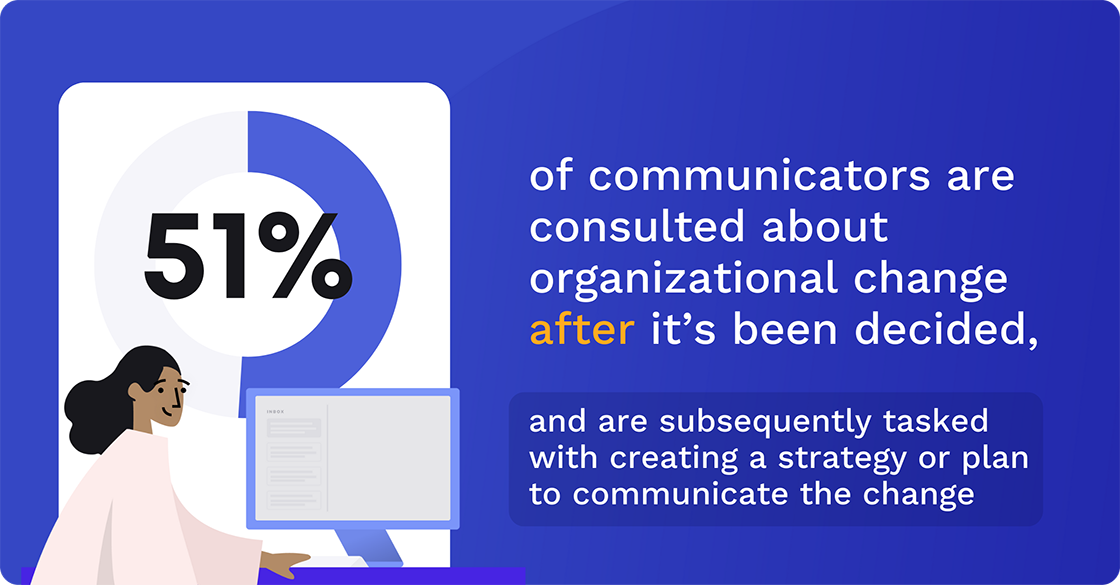
The importance of communicating organizational change cannot be overstated. It plays a crucial role in the transition process, affecting outcomes, employee engagement, and the overall health of the organization.After all, effective communication is crucial for the success of change initiatives.
The fact is that almost every company experiences some level of change at some point. The key is that management during change requires strong communication and it can’t happen without good leadership.
Maddy draws attention to the importance of communication managers in change management. They warn organizations not to start change projects without involving corporate communities. They also caution organizations from waiting until transformation processes begin to fail. Internal communicators should not be given the “role of savior” when it all goes wrong. Rather, “get IC involved from the start!”
We know that it is critically important to communicate organizational change. Here’s why:
Effective communication provides all members of an organization with a clear understanding of the change, its reasons, and its intended outcomes. For this reason, communicating change eliminates confusion and misinterpretations, ensuring everyone is on the same page. This clarity is vital for aligning organizational goals with employee actions and for navigating the change process smoothly.
Change can be met with resistance, especially if it's unexpected or perceived to be negative. By communicating change openly and honestly, management can address concerns. They can also explain the benefits of change, and show how it aligns with the organization's vision. This transparency helps to mitigate resistance, facilitates employee buy-in, and fosters a culture of trust.
Effective communication is a linchpin in change management strategies. It ensures that objectives are understood, resources are aligned, and timelines are clarified. Moreover, it allows for the adjustment of strategies based on feedback and emerging challenges. Without proper change communications, even well-planned changes can falter, failing to achieve their intended objectives.
Upgrade your company’s internal comms to enhance employee communication

Organizations that excel in communicating and implementing change can adjust more rapidly to market demands and opportunities. This agility offers a significant competitive advantage. By effectively communicating change, organizations can ensure quicker adaptation, maintain operational efficiency, and sustain their competitive edge in an ever-evolving marketplace.

Communicators often don’t know or realize they aren’t alone when they face change, says Maddy. “It’s how they execute the change that can make it succeed or fail.”
This is her advice.
Change at any level is difficult. But it’s how you frame it that can either be a net positive or net negative for any organization.
For example, changes in leadership are likely to immediately cause deep concern for employees who will be worried about their professional futures. Understanding the frustrations employees had with old leadership can be a way to highlight how the new regime will approach the same situations differently.
When massive change occurs, pretending that everything is hunky-dory is a sure way to turn off employees. You will also be likely to lose trust and faith from those who are essential to the success of your company.
Stating that you acknowledge difficulties is not a sign of defeat or weakness. It allows employees to connect and relate on a human level.
Leading on from relating on a human level… while “corporate speak” is required, when speaking to humans you need to speak like a human!
During times of critical change, those who have had to make hard or easy, happy or sad decisions to get to where you’re at, are typically mired in the decision they just made… and they had to make it.
Communicators have a unique opportunity to provide guidance to decision-makers. There are ample ways that they can provide employees with ways to gather change information. There are also a range of available outlets to ask questions, provide feedback and partake in the overall discussion.
Those who are communicating change need to take the lead and be the guide.
Redefine your new baselines.
It is crucial to use metrics for your specific campaigns after a major change. It’s almost like A.D. vs B.C. (It’s a broadly understood good example).
Communicators need to be able to look at the metrics for the campaign before change and subsequently after change (see #2 below). This will help you understand some key indicators and your employees’ experience in their overall engagement.
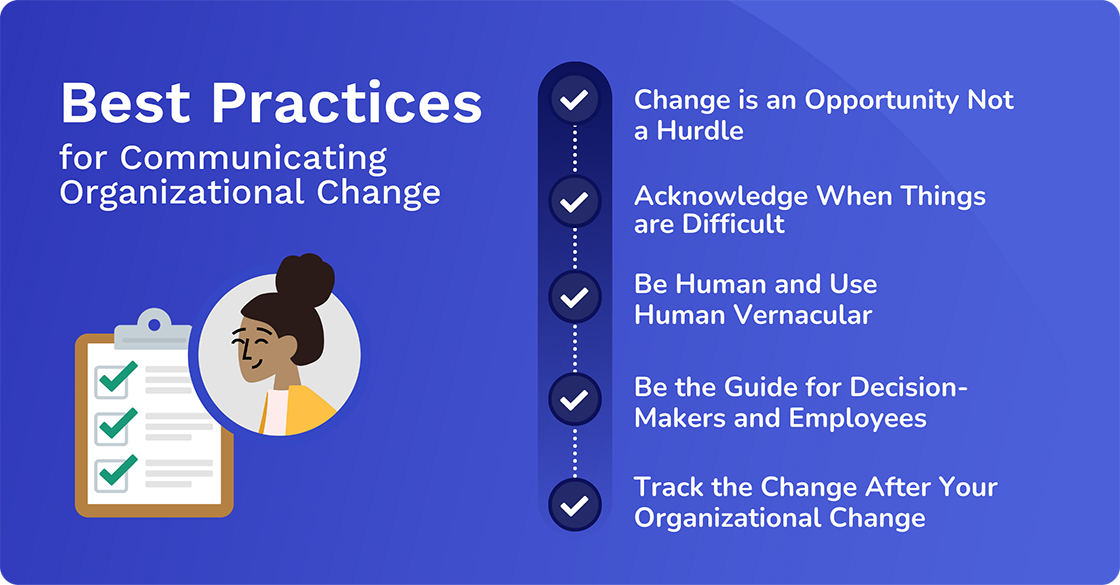
Here are eight stages to follow to ensure success. They include all-important planning phases.
When an organization decides, or is forced to implement a change, the first step is always to define what they aim to achieve. Clear objectives and goals provide a foundation for all subsequent actions and serve as a beacon throughout the change process. These objectives should be specific, measurable, achievable, relevant, and time-bound (SMART).
Establishing goals ensures everyone understands the direction and purpose, aligning efforts across the organization. The success of the change initiative begins with this clarity.
Understanding the ripple effect of the proposed changes is pivotal. A change impact assessment will evaluate how organizational change will affect different aspects of the business, including employees, processes, technology, and culture. It also identifies the potential hurdles and support needed at every level.
We’ve talked about how important planning is. By assessing potential impacts early on, organizations can proactively plan how to address them.
Commitment of leadership is the backbone of successful change initiatives. Leaders must not only endorse change but actively champion it. Their role includes motivating employees, addressing concerns, and providing clear direction. Similarly, identifying and involving key stakeholders early ensures their support and helps to mitigate resistance.
Ultimately, proactive engagement fosters a sense of ownership and commitment to the change process.
A compelling narrative is essential for connecting emotionally with employees and helping them understand the “why” behind any kind of change. The story should articulate the reasons for the change, the benefits it will bring, and the potential risks of not changing (if that is even possible).
It’s about painting a clear picture of the future and generating excitement for what’s to come. But it’s crucial for this narrative to be authentic and to resonate with company culture and employees’ values.
In today’s diverse work environment, leveraging multiple communication channels ensures that key messages relating to change reach all parts of the organization. These channels might include emails, internal intranet postings, town hall meetings, and digital media. Each channel has its strengths, and using a mix can cater to different learning styles and preferences.
Additionally, consider non-traditional channels like a branded internal comms app for real-time updates and feedback. The key is to ensure consistent messaging across all platforms, making change communications clear and accessible to everyone.
Two-way communication fosters a participative environment where employees can share their thoughts, concerns, and suggestions regarding the change. This can take the form of Q&A sessions, feedback forms, and interactive workshops. These opportunities help in addressing employees' concerns. They also provide valuable insights that can refine and improve the change process.
Active listening during these sessions is critical. It reinforces to employees that their opinions matter and that they are an integral part of the change process. This involvement can significantly boost morale and encourage the adoption of the change.
To amplify the effectiveness of this step, managers must be trained and supported to become effective communicators and change agents themselves.
Managers play a crucial role in mediating the change between leadership and employees. They need to be well-prepared to explain changes, answer questions, and provide support. This necessitates targeted training and resources that equip them with the necessary skills, technology, and knowledge.
Training might cover topics like communicating change effectively, managing resistance, and providing emotional support. Managers who are confident in their understanding and communication of the change can significantly influence the positive reception and successful implementation of a change initiative.
But it is essential to improve leadership communication and train them properly. According to Gallup’s 2024 Employee Engagement Strategies Checklist, this is destined to be one of the most important engagement strategies in 2024. But only three in ten managers strongly agree their supervisors keep them informed about what‘s happening in the organization. And only 48% of managers strongly agree that they have the skills needed to be exceptional at their job. Clearly, they need more training. How can they communicate organizational change downwards if they don’t have the skills and aren’t informed themselves?
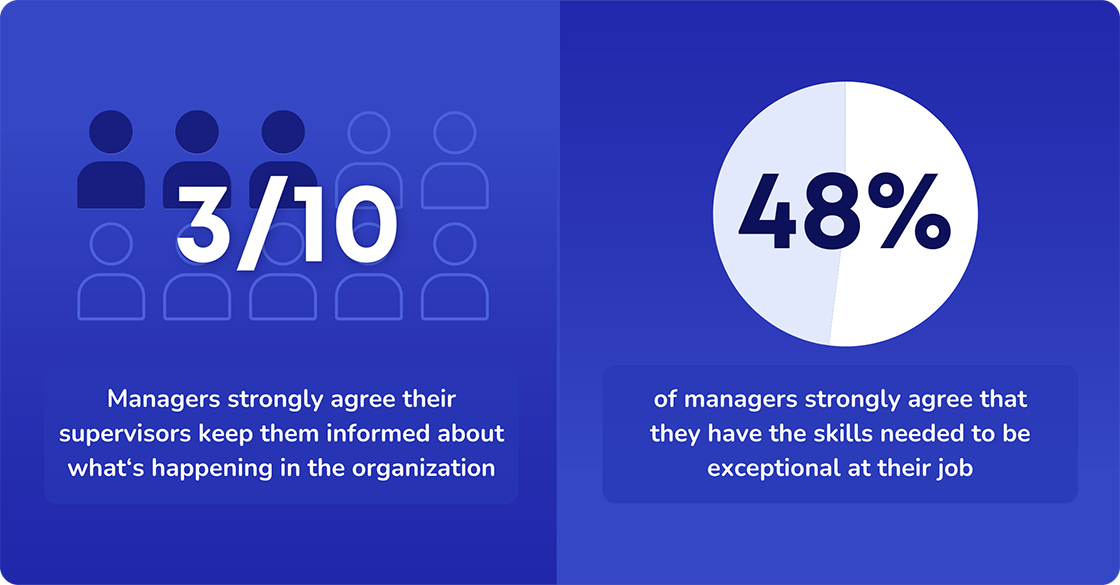
Assessing the effectiveness of a communication strategy is the final step in ensuring the success of any change initiative. This can be done via surveys, focus groups, feedback, and metrics that assess employee engagement levels. Tracking these indicators over time provides insights into what’s working and what needs adjustment.
An ongoing evaluation and adjustment process keeps the change initiative on track and maximizes its chances for success.

Cerkl recognizes how important it is to tailor strategies to your specific company culture and employee needs, particularly in times of change. Broadcast is a versatile platform with a host of features from pulse surveys and Email Blasts to personalized employee newsletters. All of these can help immensely in times of change, including M&As.
Custom fields provide a super-easy way to communicate changes in desk allocations and new leadership with organizational restructures. They can be used literally for anything that is variable. Also, data can be uploaded and automatically populated based on recipients.
How effective is your current communications plan? How well does it work when it comes to communicating change?
We can help you assess the effectiveness of your existing internal communications plan for change. Our strategic internal communications audit is all you need.
Once you’ve completed the audit, we’ll be here to make suggestions and help you improve your communications strategies using Cerkl Broadcast.
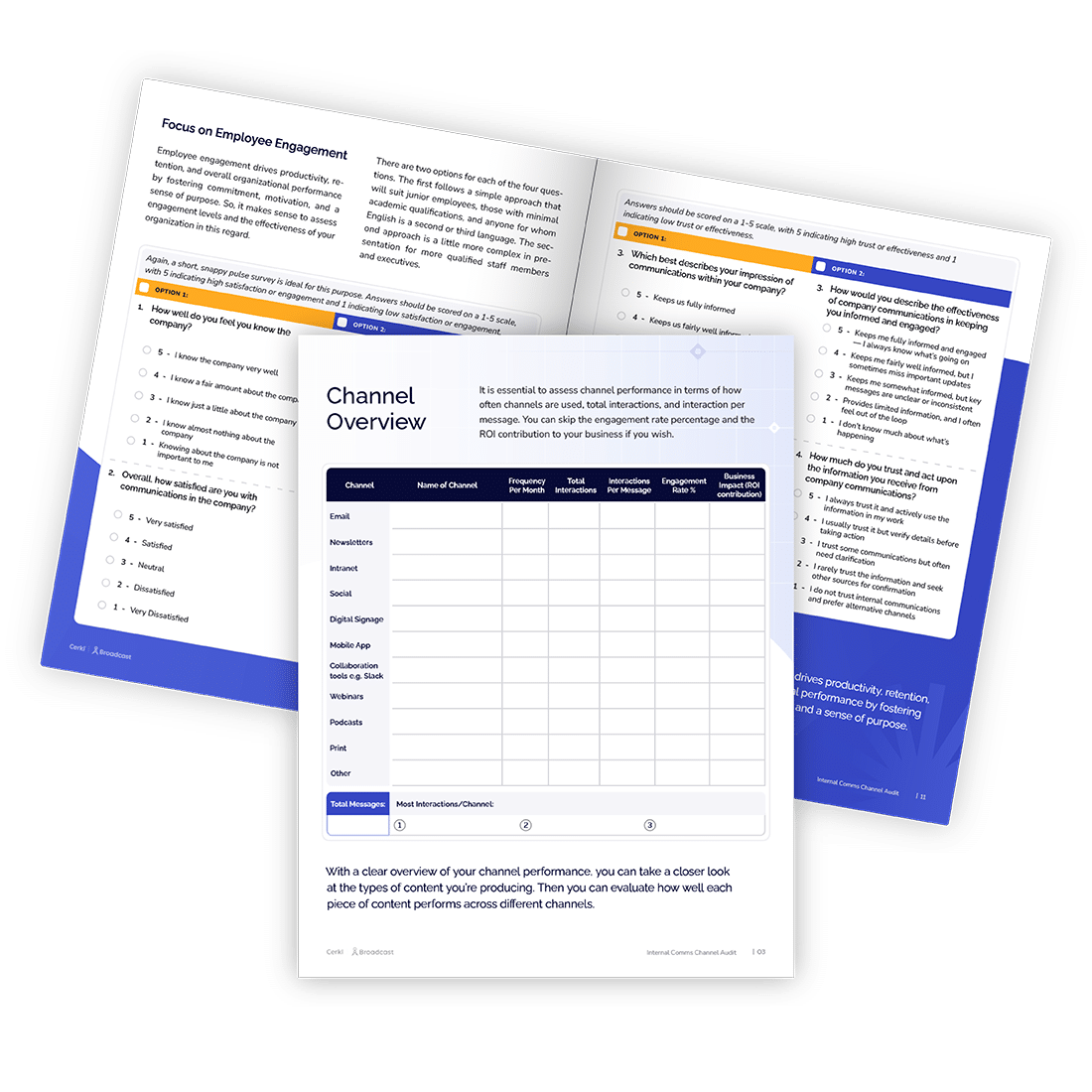
Upgrade your company’s internal comms to enhance employee communication
Why is communication important during change? During change, communication reduces fear and uncertainty, allowing people to understand the "why" and "how" behind the changes. It also enables communicators to gather feedback and ensure a smoother transition.
When should change be communicated? Change should be communicated early and often, throughout the entire process. This keeps everyone informed, avoids rumors, and allows for adjustments based on employee input.
How do you communicate change in a positive way? Focus on the positive aspects of change when communicating it. Highlight the benefits for employees and the organization, and express enthusiasm for the future. Encourage questions and open dialogue to address concerns.

Upgrade your company’s internal comms to enhance employee communication